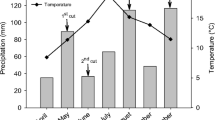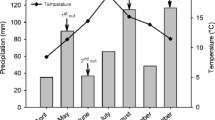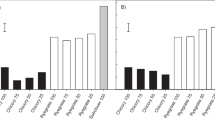Abstract
Nitrogen (N) fertiliser and clover cultivar choice affect competition and productivity in grass-clover mixtures. Pure stands and mixtures of perennial ryegrass and white clover cultivars with contrasting growth habits were examined. The aim of this work was to study the effect of repetitive nitrogen (N) application and cultivar combination on competition and productivity, N yield in the harvested herbage, N2 fixation in mixtures and pure stands, and transfer of N from clover to the companion grass. Large-leaved white clover cultivar Alice and small-leaved cv. Gwenda and perennial ryegrass cvs. Barlet (erect) and Heraut (prostrate) were sown in pure stands and as four binary grass-clover mixtures on a sandy soil in 1995. In the mixtures, two levels of N fertiliser were applied: 0 (-N) and 150 and 180 kg ha-1 y-1 N (+N) in 1996 and 1997, respectively, while the grass monocultures received three N levels (0, 140/180 and 280/360 kg ha-1) in 1996 and 1997, respectively. No N was applied to pure clover. The plots were cut five times during 1996 and six times during 1997. Fertiliser N was applied in early spring and after every harvest. The treatments were continued until the summer of 1999. In pure grass, the applied N was effectively recovered. In mixtures, N application affected competition by enhancing grass growth and the overall effect of N application was 17 kg DM per kg N applied in 1996. However, there was no yield response to N fertilizer in 1997, because this was compensated for by a higher clover production in unfertilised mixtures. In 1997, -N mixtures yielded more N than +N mixtures, owing to the higher clover content and N2 fixation. Large-leaved clover cv. Alice was better able to withstand the negative effect of repetitive N application on clover production in mixtures and increased its proportion during the growing season of the second harvest year. In 1997, mixtures with Alice yielded more N than mixtures with Gwenda, but in pure clover swards, there was no cultivar effect on N yield. Also, during the autumn of 1998 and the spring of 1999, the clover content was
highest in mixtures with Alice. Harvested N and apparent N2 fixation were almost twice as high in 1997 as in 1996. N yield and apparent N2 fixation were higher in pure clover than in mixtures. In mixtures, the apparent N2 fixation in 1996 was 142 kg N ha-1, irrespective of cultivar or N treatment. In 1997, it was on average 337 kg N ha-1, and higher in -N mixtures and in mixtures with Alice. For each tonne of clover DM in the harvested herbage, 65 and 57 kg N was harvested in 1996 and 1997 in -N mixtures, respectively. The apparent transfer of clover-derived N to grass was on average 29 and 70 kg N ha-1 yr-1 in 1996 and 1997, respectively. It was highest in +N mixtures and highest in mixtures with Gwenda in 1997. In contrast to clover, the grass cultivars were very similar in their productivity and seasonal patterns, despite their contrasting growth habits. Seasonal trends in N yield, N transfer and N recovery are discussed in relation to fertilizer application regimes and variation in production patterns in mixtures and pure stands.
Similar content being viewed by others
References
Bland B F 1967 The effect of cutting frequency and root segregation on the yield from perennial ryegrass white clover associations. Journal of Agricultural Science, Cambridge 69, 391–397.
Bleeker A and Erisman J W 1996 Depositie van verzurende componenten in Nederland in de periode 1988-1995. RIVM rapport 722108018, Den Haag.
Caradus J R, Woodfield D R and Stewart A V 1996 Overview and vision for white clover. In White Clover: New Zealand's Competitive Edge. Ed. D R Woodfield. pp 1–6. Proceedings of a joint symposium between Agronomy Society of New Zealand and New Zealand Grassland Association, Lincoln University, New Zealand, 21-22 Nov., 1995.
Collins R P, Fothergill M and Rhodes I 1996 Interactions between seedlings of perennial ryegrass and white clover cultivars in establishing swards. Grass Forage Sci. 51, 163–169.
Cowling D W 1961. The effect of nitrogenous fertiliser on an established white clover sward. J. British Grassland Soc. 16, 65–68.
Cowling D W, Green J O and Green S M 1964 The effect of white clover and nitrogenous fertilizer on the production of a sward. 3. Statistical interpretation of their relative contributions. J. British Grassland Soc. 19, 419–424.
Crush J R 1987 Nitrogen fixation. In White Clover. Eds MJ Baker and WM Williams. pp 185–201. CAB International, Wallingford.
Davidson I A and Robson M J 1986 Effect of temperature and nitrogen supply on the growth of perennial ryegrass and white clover II. A comparison of monocultures and mixed swards. Ann. Botany 57, 709–719.
Ebskamp A G M, Bonthuis H and Van Huet S M 1995 70e Rassenlijst voor Landbouwgewassen 1995.
Elgersma A, Bol R and Saunders I 1997 The use of natural abundance of 15N to study gross N transfers in grass-clover mixtures. pp 123–124. Proc. 5th Research Conference of the British Grassland Society. 8-10 Sept. 1997, Plymouth, UK.
Elgersma A and Hassink J 1997 Effects of white clover (Trifolium repens L.) on plant and soil nitrogen and soil organic matter in mixtures with perennial ryegrass (Lolium perenne L.). Plant Soil 197, 177–186.
Elgersma A, Nassiri M and Schlepers H 1998 Competition in perennial ryegrass - white clover mixtures under cutting. I. Dry-matter yield, species composition and nitrogen fixation. Grass Forage Sci. 53, 353–366.
Elgersma A and Schlepers H 1997 Performance of white clover - perennial ryegrass mixtures under cutting. Grass Forage Sci. 52, 134–146.
Elgersma A and Schlepers H 1999 Establishment, winter survival and spring performance of autumn-sown mixed swards: effects of clover and grass cultivars and weed dynamics. EU COST Action 814 - Crop Development for the Cool and Wet Regions of Europe. Proc. of the workshop on N-use efficiency, Belgium, pp. 98-116.
Evans D R, Hill J, Williams T A and Rhodes I 1985 Effects of coexistence on the performance of white clover - perennial ryegrass mixtures. Oecologia 66, 536–539.
Evans D R, Williams T A and Mason S A 1990 Contribution of white clover varieties to total sward production under typical farm management. Grass Forage Sci. 45, 129–134.
Fisher A and Wilman D 1995 Effect of interval between harvest and spring-applied fertilizer N on the growth of white clover in a mixed sward. Grass Forage Sci. 50, 162–171.
Fisher NM 1996 The potential of grain and forage legumes in mixed farming systems. In Legumes in Sustainable Farming Systems. Ed. D Younie. pp 290–299. Occ. Symp. No. 30, British Grassland Society.
Frame J 1987 The effect of strategic fertiliser nitrogen and date of primary harvest on the productivity of a perennial ryegrass/white clover sward. Grass Forage Sci. 42, 33–42.
Frame J and Boyd A G 1987 The effect of fertilizer nitrogen rate, white clover variety and closeness of cutting on herbage productivity from perennial ryegrass/white clover swards. Grass Forage Sci. 42, 85–96.
Frame J, Charlton J F L and Laidlaw A S 1998 Temperate Forage Legumes. CAB International, Wallingford, UK.
Frame J and Newbould P 1986 Agronomy of white clover. Adv. Agronomy 40, 1–88.
Genstat 5 Committee (1987) Genstat 5 Reference Manual, Oxford: Blackwell.
Harris W 1987 Population dynamics and competition. In White Clover. Eds M J Baker and W M Williams. pp 203–297. CAB International, Wallingford.
Høgh-Jensen H and Schjoerring J K 1997 Interactions between white clover and ryegrass under contrasting nitrogen availability: N2 fixation, N fertilizer recovery, N transfer and water use efficiency. Plant Soil 197, 187–199.
Jørgensen F V, Jensen E S and Schjoerring J K 1999 Dinitrogen fixation in white clover grown in pure stand and mixture with ryegrass estimated by the immobilized 15N isotope dilution method. Plant Soil 208, 293–305.
Kristensen E S, Høgh-Jensen H and Kristensen I S 1995 A simple model for estimation of atmospherically-derived nitrogen in grass-clover systems. Biol. Agric. Horticulture 12, 263–276.
Laidlaw A S 1984 Quantifying the effect of nitrogen fertiliser applications in spring on white clover content in perennial ryegrass-white clover swards. Grass Forage Sci. 39, 317–321.
Laidlaw A S 1988 The contribution of different white clover cultivars to the nitrogen yield of mixed swards (Research Note). Grass Forage Sci. 43, 347–350.
Mackenzie G H and Daly M 1982 Nitrogen use on perennial ryegrass-white clover swards. Grass Forage Sci. 37, 181–183.
Mallarino A P, Wedin W F, Perdomo C H, Goyenola R S and West C P 1990 Nitrogen transfer from white clover, red clover and birdsfoot trefoil to associated grass. Agron. J. 82, 790–795.
Marriott C A 1988 Seasonal variation in white clover content and nitrogen fixing (acetylene reducing) activity in a cut upland sward. Grass Forage Sci. 43, 253–362.
McEwen J and Johnston A E 1985 Factors affecting the production and composition of mixed grass/clover swards containing modern high yielding clovers. In Proc. of the 18th Colloquium, Edinburgh, Int. Potash Inst., Berne. pp 47–61.
Morrison J, Jackson M V and Sparrow P E 1980 The response of perennial ryegrass to fertiliser nitrogen in relation to climate and soil. Technical Report no. 27, Grassland Research Institute, Hurley.
Nassiri M and Elgersma A 1998 Competition in perennial ryegrass - white clover mixtures under cutting. II. Leaf characteristics, light interception and dry matter production during regrowth. Grass Forage Sci. 53, 367–379.
Reid D 1970 The effect of a wide range of nitrogen application rates on the yields from a perennial ryegrass sward with and without white clover. J. Agric. Sci. Cambridge 74, 227–240.
Reid D 1983 The combined use of fertilizer nitrogen and white clover as nitrogen souces on herbage growth. J Agric. Sci. 100, 613–623.
Rhodes I and Harris W 1979 The nature and basis of differences in sward composition and yield in grass /white clover mixtures. In Changes in Sward Composition and Productivity. Ed. A M Charles. pp 55–60. Occasional Symposium of the British Grassland Society no. 10.
Schils R L M 1997 Effect of a spring application of nitrogen on the performance of perennial ryegrass - white clover swards at two sites in the Netherland. Neth. J. Agric. Sci. 45, 263–275.
Soussana J F and Arregui M C 1995 Effect of mixed cropping on the nitrogen nutrition and growth of perennial ryegrass and white clover. Agronomie 15, 81–96.
Spedding C R W and Diekmahns E C (eds) 1972 Grasses and Legumes in British Agriculture. Commonw. Agric. Bur., Farnham Royal, England.
Suckling F E T 1960 Productivity of pasture species on hill country. New Zealand J. Agric. Res. 3: 579–591.
Whitehead D C 1995 Grassland Nitrogen. CAB International, Wallingford, UK. 397 pp.
Wilman D and Asiegbu J E 1982 The effects of variety, cutting interval and nitrogen application on the morphology and development of stolons and leaves of white clover. Grass Forage Sci. 37, 15–27.
Woledge J 1988 Competition between grass and clover in spring as affected by nitrogen fertiliser. Ann. Appl. Biol. 112, 175–186.
Wolton K M and Brockman J S 1970 The effect of fertilizer nitrogen and white clover on herbage production. J. British Grassland Society 25, 7–19.
Rights and permissions
About this article
Cite this article
Elgersma, A., Schlepers, H. & Nassiri, M. Interactions between perennial ryegrass ( Lolium perenne L.) and white clover (Trifolium repens L.) under contrasting nitrogen availability: productivity, seasonal patterns of species composition, N2 fixation, N transfer and N recovery. Plant and Soil 221, 281–299 (2000). https://doi.org/10.1023/A:1004797106981
Issue Date:
DOI: https://doi.org/10.1023/A:1004797106981




